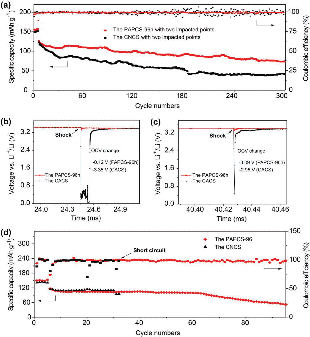Researchers Develop A Nacre-Inspired Separator Coating for Impact-Tolerant Lithium Batteries
Lithium batteries are easy to explode? Scientists at University of Science and Technology of China (USTC) may have a way to prevent.
In modern life, lithium-ion batteries are used as mobile power sources in all aspects of daily life, thus the safety of lithium-ion batteries is very important. As a key component of lithium-ion batteries, the separators strongly influence the performance and in particular the safety of lithium batteries.
However, under the stress of external shock, the widely used microporous polyolefin separator is easily deformable, accompanied with the change of inside porous network, including the pore closure, leading to the inhomogeneous Li+ ion flux in the lithium battery, which will create high local current density to trigger lithium dendrite growth on the electrode, resulting in short-circuit and even explosion of lithium batteries.
Therefore, it is very important to develop a good impact resistant separator for improving the safety of lithium batteries.
Recently, a research team led by professor YAO Hongbin, NI Yong and YU Shuhong from University of Science and Technology of China (USTC) of the Chinese Academy of Sciences proposed a nacre-inspired coating on the separator to improve the safety of lithium battery under external impact. The study was published in Advanced Materials.
In the study, they developed an alkaline-solution-induced etching method in the aragonite platelets to dissolve the protein matrix along with some parts of amorphous calcium carbonate to yield porous structure.
Then they developed a nacre-inspired separator via fabricating multilayered coating consisted of the porous aragonite platelets (PAPs) bonded by the polymer to replace the commercial ceramic nanoparticle coating. The PAP-coated separator (PAPCS) exhibits a higher tensile strength, better electrolyte wettability, and smaller thermal shrinkage in comparison to the commercial ceramic nanoparticle coated separator (CNCS).

Schematic impact-tolerance comparison of commercial separator and nacre-inspired separator. (Image by SONG Yonghui et al.)
Besides showing a little better thermal stability and electrochemical performance, the PAPCS can endow the battery with more excellent deformation-resistant capability than the CACS when encountering the external impaction. They used the same pellets to impact CNCS and nacre-inspired coating separator at the same height, and then used scanning electron microscopy to observe changes in the pore structure of the separator. They found that the pore structure inside the nacre-inspired coating separator was well retained by the impact of the small pellet, while the internal pores of the CNCS showed a very pronounced deformation due to the impact. Also, they showed that the pouch cell using the fabricated nacre-inspired separator exhibits good cycling stability under external shock, which is in sharp contrast to the fast short circuit of the pouch cell using commercial CNCS.

Electrochemical performance comparison of the cells using the PAPCS and the CNCS to test the deformation resistance. (Image by SONG Yonghui et al.)
The developed nacre-inspired protection strategy will open a new avenue for improving the safety of lithium batteries. The researchers believe the methodology used in this study is very suitable for industrialization. However, more stringent testing of the current separator is required before it is actually industrialized. If it can pass the characterization test of the battery industry, this project can be industrialized in the next two years.
Next, the researchers are looking for novel bio-inspirations to develop new separators with high mechanical properties and lithium-ion transference number. They want to build a prismatic/nacre composite membrane material that further enhances the impact resistance of lithium-ion batteries. Their ultimate goal is to provide advanced separators for high performance and safe lithium batteries.

